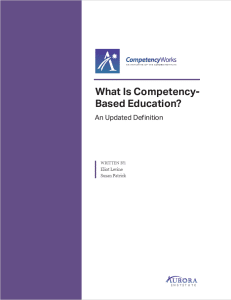November 6, 2024
 Competency-based education, an educator-led reform, is taking root in schools and districts across the country. The concept behind competency-based education is simple: learning is best measured by students demonstrating mastery of learning, rather than the number of hours spent in a classroom. By redesigning the education system around actual student learning, we will prepare each student more effectively for a future in an increasingly global and competitive economy.
Competency-based education, an educator-led reform, is taking root in schools and districts across the country. The concept behind competency-based education is simple: learning is best measured by students demonstrating mastery of learning, rather than the number of hours spent in a classroom. By redesigning the education system around actual student learning, we will prepare each student more effectively for a future in an increasingly global and competitive economy.
Competency-based education is a major shift in school culture, structures, and pedagogy focused on ensuring that all students succeed and addressing fundamental shortcomings of the traditional model. Districts and schools turn to competency-based education for different reasons: to help students learn most effectively, to achieve greater equity, to foster deeper learning, or to create a system of continuous improvement.
Competency-based education is being implemented at deeper levels in more schools and districts every year, and most states have made initial or extensive policy adjustments to allow for competency-based education innovations. Many districts are making the transition because they know they can’t help all of their students reach career and college readiness without greater personalization.
Competency-based education is a system in which:
- Students are empowered daily to make important decisions about their learning experiences, how they will create and apply knowledge, and how they will demonstrate their learning.
- Assessment is a meaningful, positive, and empowering learning experience for students that yields timely, relevant, and actionable evidence.
- Students receive timely, differentiated support based on their individual learning needs.
- Students progress based on evidence of mastery, not seat time.
- Students learn actively using different pathways and varied pacing.
- Strategies to ensure equity for all students are embedded in the culture, structure, and pedagogy of schools and education systems.
- Rigorous, common expectations for learning (knowledge, skills, and dispositions) are explicit, transparent, measurable, and transferable.
A competency-based school should implement all seven elements of the definition. Strong implementation also requires policies, pedagogy, structures, and culture that support every student. These topics are explained further in What Is Competency-Based Education? An Updated Definition and Quality Principles for Competency-Based Education.
A Note About Language
As you learn about competency-based education you will encounter multiple phrases used to capture the practice of students advancing upon mastery: standards-based, mastery-based, performance-based, or proficiency-based.
CompetencyWorks uses the phrase “competency-based education.” Why? When we started, states were already using different terms. So we decided to use the term that the U.S. Department of Education was using at the time.
What we call it isn’t important. What is important is that we share a working definition that drives policy and practice towards a learner-centered system in which success is the only option.
CompetencyWorks Posts
September 26, 2025
Thinking Ahead: AI in Math Education
August 22, 2025
A Garden Grows in Greenup: Rethinking Learning, Accountability, and Community Connection
July 23, 2025
Impact of Recent Supreme Court Ruling on US Department of Education Staffing Cuts on Students and Families: An Update from FullScale
July 18, 2025
Reimagining School Starts with Reclaiming Time
July 17, 2025